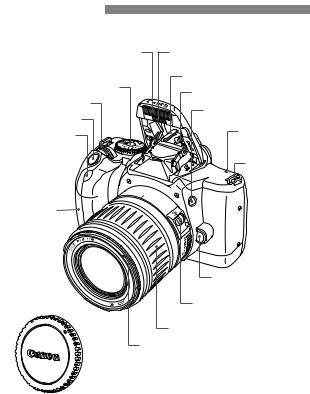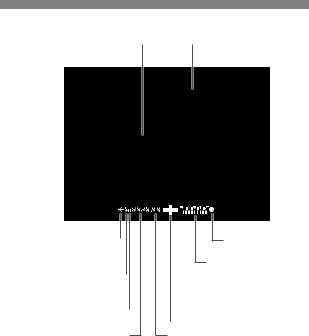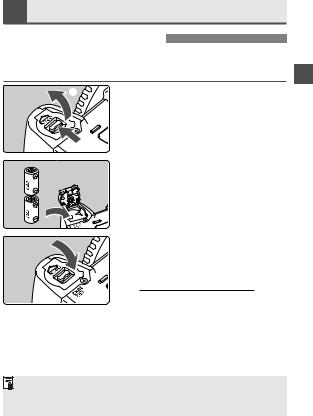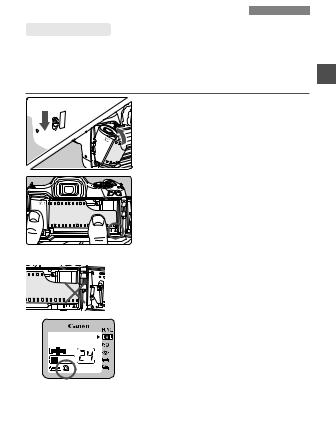CANON EOS 3000V User Manual

 /
/ 


 /
/ 




English
E
INSTRUCTIONS

Thank you for purchasing a Canon product.
The EOS REBEL K2 (DATE) / 3000V (DATE) is a very compact autofocus, single-lens reflex camera. It can be used for a wide variety of subjects and situations with fully automatic and usercontrolled shooting modes.
Read this Instructions and familiarize yourself with your new camera before taking pictures.
Also read “Handling Cautions” on page 4 to prevent camera malfunction and damage.
Keep this instruction booklet handy for easy reference.
Before Using Your Camera
•Before shooting an important event, be sure to take test shots to make sure the camera operates properly.
•EOS cameras have a lens mount for dedicated operation (autofocusing, exposure control, etc.) with Canon EF lenses. Using a non-Canon EF lens with an EOS camera may not result in proper camera or lens operation. Note that the warranty does not cover any camera malfunction or damage occurring with the use of non-Canon products.
Conventions Used in this Instructions
•The <l> icon indicates the Main Dial.
•All operation procedures described in this booklet assume that the Mode Dial is set to a mode except <:>. Before proceeding with any operation, be sure that the Mode Dial is set to a shooting mode.
•Reference page numbers are indicated by (p. ).
•The camera control icons and markings used in this booklet correspond to the actual icons and markings found on the camera.
•The (˜) and (∫) icons indicate that the respective function remains in effect for 4 and 6 sec. respectively after the button is released.
2

Contents
1
2
3
Conventions Used in this Instructions ................................ |
2 |
Handling Cautions .............................................................. |
4 |
Nomenclature ..................................................................... |
6 |
Before You Start................................................... |
11 |
Installing the Batteries ...................................................... |
11 |
Checking the Battery Level............................................... |
12 |
Mounting and Detaching a Lens....................................... |
13 |
How the Shutter Button Works ......................................... |
14 |
=Loading and Unloading Film ........................................ |
15 |
¢Midroll Rewind ...................................................... |
16 |
Fully Automatic Shooting................................... |
17 |
Since everything is automatic, all you do is press the |
|
shutter button. |
|
User-Controlled Shooting................................... |
27 |
You can set the desired shutter speed or aperture value to |
|
obtain the exposure you want. You take control of the |
|
camera. |
|
Reference ............................................................. |
44 |
Symbols
The Caution symbol alerts you to actions to prevent shooting problems.
The Note symbol gives supplemental information.
3

Handling Cautions
Camera Care and Storage
•The camera is a precision instrument. Do not drop it or subject it to physical shock.
•The camera is not waterproof and should not be used in wet conditions or underwater. If the camera gets wet, take it to your nearest Canon dealer as soon as possible. If small amounts of water splash onto the camera, wipe it with a clean dry cloth. If the camera is exposed to salty air, wipe it thoroughly with a slightly damp cloth.
•Do not leave the camera in places prone to excessive heat such as in a car on a sunny day. Excessive heat can cause the camera to malfunction.
•The camera contains precision electronic circuitry. Never attempt to disassemble the camera.
•Use only a blower brush to blow away any dust on the lens, eyepiece, mirror, focusing screen, film compartment, etc. Do not clean the camera body or lens with any cleaner containing an organic solvent. For stubborn dirt, consult your nearest Canon dealer.
•The shutter curtains are extremely thin. Use only a blower to clean them. Be careful not to blow air too forcefully on the shutter curtains. The shutter curtains can be easily deformed or damaged. Also, when loading and unloading film, be careful not to touch the shutter curtains.
•Do not touch the electrical contacts with your fingers. Otherwise corrosion may develop on the contacts, resulting in improper camera operation.
•If the camera is not to be used for an extended period, remove the battery. Store the camera in a well-ventilated, cool, dry place. During the storage period, press the shutter button to release the shutter a few times once in a while.
•Avoid storing the camera in a laboratory, cabinet, etc., where corrosive chemicals are present.
4

•If you have not used the camera for some time or are planning to take shots you will not want to lose (overseas vacation, etc.), have the camera checked by your Canon dealer beforehand, or check for yourself that the camera components are working properly.
LCD Displays
By their nature, LCD displays react more slowly at low temperatures, and may appear dark at high temperatures. The display will return to normal at room temperature.
Batteries
•Before installing the batteries, wipe the battery contacts to remove any fingerprints and smudges. This is to prevent faulty connections and corrosion.
•Never disassemble or recharge the batteries. Also, never store a battery in high-temperature places or short circuit the battery contacts or toss a battery into a fire.
•Although the batteries work well even at low temperatures, battery performance may decline slightly at freezing temperatures. In such a case, keep spare batteries warm in a pocket, etc., and use and warm the batteries alternately.
How Low Battery Levels Affect Camera Operation
On the LCD panel, if the <π> icon blinks or it is not displayed, a proper exposure can still be obtained as long as the shutter releases. However, when the battery level is low, film advance and auto rewind might stop midway or not work at all and <π> icon may blink on the LCD panel. After the batteries are replaced with new ones, film advance will be possible and film rewind can resume by pressing the <¢> button.
Lens Electrical Contacts
After detaching the lens from the camera, put |
Contacts |
|
|
on the lens caps or put down the lens with |
|
the rear end up to avoid scratching the lens |
|
surface and electrical contacts. |
|
5

Nomenclature
• Reference page numbers are indicated by (p. ).
Built-in flash / AF-assist beam (p.43/19)
Mode Dial (p.10)
<l> Main Dial
Shutter button (p.14)
Red-eye reduction lamp (p.22)
Hot shoe
Flash-sync contact
<M> Flash button (p.43)
*Remote control sensor / Self-timer/ *Remote control lamp (p.24/23/24)
<£> Film plane mark
Strap |
mount |
(p.7) |
Grip / Battery compartment (p.11)
Lens release button (p.13)
Focus mode switch (p.13)
Zooming ring
Focusing ring (p.30)
Body cap (p.13) |
* DATE Model only |
|
**With an EX-series Speedlite. |
6

Viewfinder eyepiece
Eyecup (p.24)
Film check window
Back cover release lever (p.15)
LCD panel (p.8)
Tripod socket
<¢> Midroll rewind button (p.16)
<∑> Aperture value setting / Exposure compensation / *SET button (p.36/38/26)
<j> AE lock (p.40) / **FE lock button
<3> AF point selection button (p.28)
Back cover
<\> Function button (p.22, 25, 26, 39, 41, 42)
Guide hole
Battery compartment cover (p.11)
Battery compartment cover release lever (p.11)
<^> Film advance mode / Self-timer/*Remote control button (p.31/23/24)
|
Attaching the Strap |
|
Pass the end of the strap through the |
2 1 |
camera’s strap mount from the bottom. Then |
pass it through the strap’s buckle as shown |
|
|
in the illustration. Pull the strap to make sure |
|
it does not slip out of the buckle. |
3• The eyepiece cover is also attached to the
 4
4
Eyepiece cover
7

Nomenclature
LCD Panel
Shutter speed |
|
|
|
|
|
<?> Manual focus |
||||||||||||||||||||||||||||||||
ISO film speed |
|
|
|
|
|
|
|
|
|
Aperture value |
||||||||||||||||||||||||||||
Date |
|
|
|
|
|
|
|
|
|
|||||||||||||||||||||||||||||
**FE lock |
|
|
|
|
|
|
|
|
|
Red-eye reduction setting |
||||||||||||||||||||||||||||
|
|
|
|
|
|
|
|
|
|
|
|
|
|
|
|
|
|
|
|
|
|
|
|
|
|
|
|
|
|
AEB amount |
||||||||
|
|
|
|
|
|
|
|
|
|
|
|
|
|
|
|
|
|
|
|
|
|
|
|
|
|
|
|
|
|
Date |
||||||||
|
|
DATE Model |
|
|
|
|
|
|
|
|
|
|
|
|
|
|
|
|
|
|
||||||||||||||||||
|
|
|
|
|
|
|
|
|
|
|
|
|
|
|
|
|
|
|
|
|
|
|
|
|
|
|
|
|
|
|
|
|
|
|
|
|
|
<;> Date |
|
|
|
|
|
|
|
|
|
|
|
|
|
|
|
|
|
|
|
|
|
|
|
|
|
|
|
|
|||||||||||
|
|
|
|
|
|
|
|
|
|
|
|
|
|
|
|
|
|
|
|
|
|
|
|
|
|
|
|
|
|
|
|
|
|
|
|
|
|
|
AF point mark |
|
|
|
|
|
|
|
|
|
|
|
|
|
|
|
|
|
|
|
|
|
|
|
|
|
|
|
|
|
|
|
|
|
|
|
|
<D> ISO film speed |
|
|
|
|
|
|
|
|
|
|
|
|
|
|
|
|
|
|
|
|
|
|
|
|
|
|
|
|
|
|
|
|
|
|
|
|
|
|||
|
|
|
|
|
|
|
|
|
|
|
|
|
|
|
|
|
|
|
|
|
|
|
|
|
|
|
|
|
|
|
|
|
<F> Red-eye reduction |
|||||
|
|
|
|
|
|
|
|
|
|
|
|
|
|
|
|
|
|
|
|
|
|
|
|
|
|
|
|
|
|
|
|
|
|
|||||
Film advance |
|
|
|
|
|
|
|
|
|
|
|
|
|
|
|
|
|
|
|
|
|
|
|
|
|
<<> Multiple |
||||||||||||
|
|
|
|
|
|
|
|
|
|
|
|
|
|
|
|
|
|
|
|
|
|
|
|
|
||||||||||||||
|
|
|
|
|
|
|
|
|
|
|
|
|
|
|
|
|
|
|
|
|
|
|
|
|
|
|
|
|
|
|
|
|
|
|
|
|
||
mode |
|
|
|
|
|
|
|
|
|
|
|
|
|
|
exposures |
|||||||||||||||||||||||
<J> Single frame |
|
|
|
|
|
|
|
|
|
|
|
|
|
|
|
|
|
|
|
|
|
|
|
|
<L> AEB |
|||||||||||||
<H> Continuous |
|
|
|
|
|
|
|
|
|
|
|
|
|
|
|
|
|
|
|
|
|
|
|
|
|
|
|
|||||||||||
|
|
|
|
|
|
|
|
|
|
|
|
|
|
|
|
|
|
|
|
|||||||||||||||||||
shooting |
|
|
|
|
|
|
|
|
|
|
|
|
|
|
|
|
|
|
|
|
||||||||||||||||||
<´> Self-timer/ |
|
|
|
|
|
|
|
|
|
|
|
|
|
|
|
<>> Function pointer |
||||||||||||||||||||||
Remote control |
|
|
|
|
|
|
|
|
|
|
|
|
|
|
|
|
|
|
|
|
|
|
|
|||||||||||||||
|
|
|
|
|
|
|
|
|
|
|
|
|
|
|
|
|
|
|
|
|||||||||||||||||||
Battery level mark |
|
|
|
|
|
|
|
|
|
|
|
|
|
|
|
|
|
|
|
|
|
|
|
|
|
|
Frame counter |
|||||||||||
|
|
|
|
|
|
|
|
|
|
|
|
|
|
|
|
|
|
|
|
|
|
|
|
|
|
|||||||||||||
|
|
|
|
|
|
|
|
|
|
|
|
|
Multiple-exposure setting |
|||||||||||||||||||||||||
|
|
|
|
|
|
|
|
|
|
|
|
|
|
|
|
|
|
|
|
|
|
|
|
|
|
|
|
|
|
|
||||||||
|
|
|
|
|
|
|
|
|
|
|
|
|
|
|
|
|
|
|
|
|
|
|
|
|
|
|
|
|
|
|
Self-timer operation |
|||||||
|
|
|
|
|
|
|
|
|
|
|
|
|
|
|
|
|
|
|
|
|
|
|
|
|
|
|
|
|
|
|
Remote control operation |
|||||||
<=> Film mark |
|
|
|
|
|
|
Exposure level indicator |
|||||||||||||||||||||||||||||||
|
|
|
|
|
|
|||||||||||||||||||||||||||||||||
|
|
|
|
|
|
|
|
|
|
|
|
|
|
|
|
|
|
|
|
|
|
|
|
|
|
|
|
Exposure compensation amount |
||||||||||
|
|
|
|
|
|
|
|
|
|
|
|
|
|
|
|
|
|
|
|
|
|
|
|
|
|
|
|
AEB level |
||||||||||
Non-DATE Model |
|
|
|
Red-eye reduction lamp-on indicator |
||||||||||||||||||||||||||||||||||
|
|
|
|
|
|
|
|
|
|
|
|
|
|
|
|
|
|
|
|
|
|
|
|
|
|
|
Film transport indicator |
|||||||||||
|
|
|
|
|
|
|
|
|
|
|
|
|
|
|
|
|
|
|
|
|
**With an EX-series Speedlite. |
|||||||||||||||||
|
|
|
|
|
|
|
|
|
|
|
|
|
|
|
|
|
|
|
|
|
||||||||||||||||||
|
|
|
|
|
|
|
|
|
|
|
|
|
|
|
|
|
|
|
|
|
||||||||||||||||||
|
|
|
|
|
|
|
|
|
|
|
|
|
|
|
|
|
|
|
|
|
• |
The actual display will show only the |
||||||||||||||||
|
|
|
|
|
|
|
|
|
|
|
|
|
|
|
|
|
|
|
|
|
|
|
|
applicable items. |
||||||||||||||
8

Viewfinder Information
AF points (7) 
<j> AE lock /  **FE lock
**FE lock
AEB in progress
<M> Flash-ready  **Improper FE lock warning
**Improper FE lock warning
<|> **High-speed sync  (FP flash)
(FP flash)
Shutter speed **FE lock
 Focusing screen
Focusing screen
<n> Focus
confirmation light
Exposure level indicator
Exposure compensation amount
AEB level Red-eye reduction lamp-on indicator
 AF point mark
AF point mark
Aperture value
9

Nomenclature
Mode Dial
The dial is divided into two zones.
|
|
|
e |
|
|
v |
|
|
ti |
|
|
|
a |
|
|
|
e |
|
|
r |
|
|
|
C |
|
|
|
Zone
 OFF
OFF 




Full Auto 
I
m
a
ge
|
|
e |
|
n |
|
o |
|
|
Z |
|
|
B
a
s
ic
|
e |
n |
|
Zo |
|
1Basic Zone
Fully automatic mode where the camera takes care of everything.
Y : Full Auto (p.18) Basically, all you do is point and shoot.
Image Zone (p.20)
Fully automatic modes for a particular subject.
U : Portrait I : Landscape O : Close-up P : Sports
A : Night Portrait S : Flash off
2Creative Zone
Semi-automatic and manual modes enable you to take control of the camera to obtain the desired result.
T : Program AE (p.32) R : Shutter-priority AE
(p.34)
E : Aperture-priority AE (p.35)
W : Manual exposure (p.36)
Q : Automatic Depth-of- field AE (p.37)
3 : : OFF
10

1 Before You Start
Batteries
Batteries are not included in camera body only (not kit) sold in North America. Obtain batteries separately.
The camera uses two CR2 lithium batteries.
2 |
battery compartment |
|
1 cover. |
• Slide the release lever in the direction shown by the arrow in the
diagram, and open the cover.

 1
1
2Install the batteries.
• Make sure the battery contacts (+ and –) are properly oriented as shown.
• Do not mix old and new batteries.
3 Closecover. the battery compartment
• Press the cover until it snaps shut.
• The date and time must be set. See page 26. (DATE Model only)
For places where CR2 batteries may not be easily available, take spare batteries with you. Also carry spare batteries for extended shooting sessions.
11

Checking the Battery Level
Check the battery level after replacing the batteries and before using the camera.
Turn the Mode Dial to a shooting mode.
• The camera will then turn on and the LCD panel will display one of the following battery level mark:
: Battery level OK.
: The battery level is low. Keep spare batteries handy.


 : The batteries will soon be
: The batteries will soon be  completely exhausted.
completely exhausted.


 : Replace the batteries.
: Replace the batteries.
Battery Life |
|
|
(With 24-ex. rolls) |
Temperature |
0% Flash Use |
50% Flash Use |
100% Flash Use |
At 20˚C |
67 rolls |
30 rolls |
22 rolls |
At –10˚C |
44 rolls |
20 rolls |
15 rolls |
•The battery life shown above is based on Canon’s testing conditions with new batteries.
• If nothing is displayed on the LCD panel, the batteries may have been installed incorrectly. Take out the batteries and install correctly.
•If you often press the shutter button halfway for a prolonged period or just autofocus without taking a picture, the battery life will be affected.
•When not using the camera, set the Mode Dial to <:>.
12

Mounting and Detaching a Lens
Mounting a Lens
1 
 2
2 


Detaching
1 Remove the caps.
•Remove the rear lens cap and the camera body cap.
2Mount the lens.
• Align the red dots on the lens and camera and turn the lens as shown by the arrow until it snaps in place.
3 On the lens, set the focus mode switch to <AF>.
• If the focus mode switch is set to <MF>, autofocus will not operate.
4Remove the front lens cap.
Lens
|
pressing the lens release |
|
2 |
the lens as shown |
|
. |
||
|
||
1 |
lens until it stops, then |
3
you will not lose them.
and <MF> stands for “Manual
to the camera.
13

How the Shutter Button Works
The shutter button has two stages. You can press it down halfway or fully. The two levels of shutter button operation are as follows:
When it is pressed halfway:
• Pressing the shutter button down halfway activates autofocusing (AF), and also activates the automatic exposure (AE) mechanism and sets the shutter speed and aperture value.
•The exposure (the combination of shutter speed and aperture value) appears on the LCD panel and in the viewfinder (˜).
When it is pressed fully:
• The shutter is released to take the picture and the film advances by one frame.
If an Extender (optional) is used and the maximum aperture (the lowest f/number) of the lens becomes smaller than f/5.6, autofocusing will not operate.
Camera movement during the moment of exposure is called camera shake. Camera shake can cause blurred pictures. To prevent blurred pictures due to camera shake:
•Hold the camera steady.
·Firmly grasp the camera grip with your right hand, and press your both elbows lightly against your body.
·Hold the lens at the bottom with your left hand.
·Press the camera against your face and look through the viewfinder.
·To maintain a stable stance, place one foot in front of the other instead of lining up both feet.
•Use your finger tip to touch the shutter button, grasp the camera with your entire right hand, then press the shutter button gently.
14

=Loading and Unloading Film
Loading Film
After you load the film, the camera first winds the entire roll onto the camera’s take-up spool. With DX-coded film, the camera automatically sets the film’s ISO speed. Then each time a picture is taken, one frame of film is rewound back into the film cartridge. The frame counter shows always number of shots remaining.









 1
1
2Open the back cover.
• Slide down the back cover release
lever and open the back.
3 Insert the film cartridge at a slight angle.
4Align the film leader edge with the <§> mark.
• Hold down the film cartridge while pulling out the film leader. If you pull out the film leader too much, rewind it back into the film cartridge.
5 Close the back cover.
• Close the back cover until it snaps shut.
s Film prewind will start and there will be a shutter-release sound about 10 sec. later. The <=> icon and frame count will also be displayed on the LCD panel.
s During the film prewind, the ISO speed will be displayed on the LCD panel.
15
